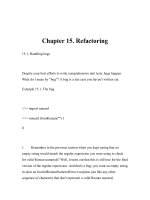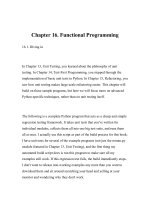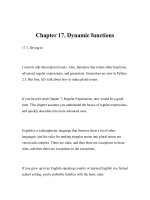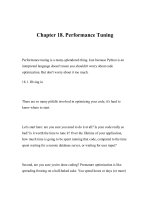Dive Into Python-Chapter 16. Functional Programming
Bạn đang xem bản rút gọn của tài liệu. Xem và tải ngay bản đầy đủ của tài liệu tại đây (163.86 KB, 36 trang )
Chapter 16. Functional Programming
16.1. Diving in
In Chapter 13, Unit Testing, you learned about the philosophy of unit
testing. In Chapter 14, Test-First Programming, you stepped through the
implementation of basic unit tests in Python. In Chapter 15, Refactoring, you
saw how unit testing makes large-scale refactoring easier. This chapter will
build on those sample programs, but here we will focus more on advanced
Python-specific techniques, rather than on unit testing itself.
The following is a complete Python program that acts as a cheap and simple
regression testing framework. It takes unit tests that you've written for
individual modules, collects them all into one big test suite, and runs them
all at once. I actually use this script as part of the build process for this book;
I have unit tests for several of the example programs (not just the roman.py
module featured in Chapter 13, Unit Testing), and the first thing my
automated build script does is run this program to make sure all my
examples still work. If this regression test fails, the build immediately stops.
I don't want to release non-working examples any more than you want to
download them and sit around scratching your head and yelling at your
monitor and wondering why they don't work.
Example 16.1. regression.py
If you have not already done so, you can download this and other examples
used in this book.
"""Regression testing framework
This module will search for scripts in the same directory named
XYZtest.py. Each such script should be a test suite that tests a
module through PyUnit. (As of Python 2.1, PyUnit is included in
the standard library as "unittest".) This script will aggregate all
found test suites into one big test suite and run them all at once.
"""
import sys, os, re, unittest
def regressionTest():
path = os.path.abspath(os.path.dirname(sys.argv[0]))
files = os.listdir(path)
test = re.compile("test\.py$", re.IGNORECASE)
files = filter(test.search, files)
filenameToModuleName = lambda f: os.path.splitext(f)[0]
moduleNames = map(filenameToModuleName, files)
modules = map(__import__, moduleNames)
load = unittest.defaultTestLoader.loadTestsFromModule
return unittest.TestSuite(map(load, modules))
if __name__ == "__main__":
unittest.main(defaultTest="regressionTest")
Running this script in the same directory as the rest of the example scripts
that come with this book will find all the unit tests, named moduletest.py,
run them as a single test, and pass or fail them all at once.
Example 16.2. Sample output of regression.py
[you@localhost py]$ python regression.py -v
help should fail with no object ... ok 1
help should return known result for apihelper ... ok
help should honor collapse argument ... ok
help should honor spacing argument ... ok
buildConnectionString should fail with list input ... ok 2
buildConnectionString should fail with string input ... ok
buildConnectionString should fail with tuple input ... ok
buildConnectionString handles empty dictionary ... ok
buildConnectionString returns known result with known input ... ok
fromRoman should only accept uppercase input ... ok 3
toRoman should always return uppercase ... ok
fromRoman should fail with blank string ... ok
fromRoman should fail with malformed antecedents ... ok
fromRoman should fail with repeated pairs of numerals ... ok
fromRoman should fail with too many repeated numerals ... ok
fromRoman should give known result with known input ... ok
toRoman should give known result with known input ... ok
fromRoman(toRoman(n))==n for all n ... ok
toRoman should fail with non-integer input ... ok
toRoman should fail with negative input ... ok
toRoman should fail with large input ... ok
toRoman should fail with 0 input ... ok
kgp a ref test ... ok
kgp b ref test ... ok
kgp c ref test ... ok
kgp d ref test ... ok
kgp e ref test ... ok
kgp f ref test ... ok
kgp g ref test ... ok
----------------------------------------------------------------------
Ran 29 tests in 2.799s
OK
1 The first 5 tests are from apihelpertest.py, which tests the example
script from Chapter 4, The Power Of Introspection.
2 The next 5 tests are from odbchelpertest.py, which tests the example
script from Chapter 2, Your First Python Program.
3 The rest are from romantest.py, which you studied in depth in Chapter
13, Unit Testing.
16.2. Finding the path
When running Python scripts from the command line, it is sometimes useful
to know where the currently running script is located on disk.
This is one of those obscure little tricks that is virtually impossible to figure
out on your own, but simple to remember once you see it. The key to it is
sys.argv. As you saw in Chapter 9, XML Processing, this is a list that holds
the list of command-line arguments. However, it also holds the name of the
running script, exactly as it was called from the command line, and this is
enough information to determine its location.
Example 16.3. fullpath.py
If you have not already done so, you can download this and other examples
used in this book.
import sys, os
print 'sys.argv[0] =', sys.argv[0] 1
pathname = os.path.dirname(sys.argv[0]) 2
print 'path =', pathname
print 'full path =', os.path.abspath(pathname) 3
1 Regardless of how you run a script, sys.argv[0] will always contain
the name of the script, exactly as it appears on the command line. This may
or may not include any path information, as you'll see shortly.
2 os.path.dirname takes a filename as a string and returns the directory
path portion. If the given filename does not include any path information,
os.path.dirname returns an empty string.
3 os.path.abspath is the key here. It takes a pathname, which can be
partial or even blank, and returns a fully qualified pathname.
os.path.abspath deserves further explanation. It is very flexible; it can take
any kind of pathname.
Example 16.4. Further explanation of os.path.abspath
>>> import os
>>> os.getcwd() 1
/home/you
>>> os.path.abspath('') 2
/home/you
>>> os.path.abspath('.ssh') 3
/home/you/.ssh
>>> os.path.abspath('/home/you/.ssh') 4
/home/you/.ssh
>>> os.path.abspath('.ssh/../foo/') 5
/home/you/foo
1 os.getcwd() returns the current working directory.
2 Calling os.path.abspath with an empty string returns the current
working directory, same as os.getcwd().
3 Calling os.path.abspath with a partial pathname constructs a fully
qualified pathname out of it, based on the current working directory.
4 Calling os.path.abspath with a full pathname simply returns it.
5 os.path.abspath also normalizes the pathname it returns. Note that this
example worked even though I don't actually have a 'foo' directory.
os.path.abspath never checks your actual disk; this is all just string
manipulation.
Note
The pathnames and filenames you pass to os.path.abspath do not need to
exist.
Note
os.path.abspath not only constructs full path names, it also normalizes them.
That means that if you are in the /usr/ directory,
os.path.abspath('bin/../local/bin') will return /usr/local/bin. It normalizes the
path by making it as simple as possible. If you just want to normalize a
pathname like this without turning it into a full pathname, use
os.path.normpath instead.
Example 16.5. Sample output from fullpath.py
[you@localhost py]$ python
/home/you/diveintopython/common/py/fullpath.py 1
sys.argv[0] = /home/you/diveintopython/common/py/fullpath.py
path = /home/you/diveintopython/common/py
full path = /home/you/diveintopython/common/py
[you@localhost diveintopython]$ python common/py/fullpath.py 2
sys.argv[0] = common/py/fullpath.py
path = common/py
full path = /home/you/diveintopython/common/py
[you@localhost diveintopython]$ cd common/py
[you@localhost py]$ python fullpath.py 3
sys.argv[0] = fullpath.py
path =
full path = /home/you/diveintopython/common/py
1 In the first case, sys.argv[0] includes the full path of the script. You
can then use the os.path.dirname function to strip off the script name and
return the full directory name, and os.path.abspath simply returns what you
give it.
2 If the script is run by using a partial pathname, sys.argv[0] will still
contain exactly what appears on the command line. os.path.dirname will
then give you a partial pathname (relative to the current directory), and
os.path.abspath will construct a full pathname from the partial pathname.
3 If the script is run from the current directory without giving any path,
os.path.dirname will simply return an empty string. Given an empty string,
os.path.abspath returns the current directory, which is what you want, since
the script was run from the current directory.
Note
Like the other functions in the os and os.path modules, os.path.abspath is
cross-platform. Your results will look slightly different than my examples if
you're running on Windows (which uses backslash as a path separator) or
Mac OS (which uses colons), but they'll still work. That's the whole point of
the os module.
Addendum. One reader was dissatisfied with this solution, and wanted to be
able to run all the unit tests in the current directory, not the directory where
regression.py is located. He suggests this approach instead:
Example 16.6. Running scripts in the current directory
import sys, os, re, unittest
def regressionTest():
path = os.getcwd() 1
sys.path.append(path) 2
files = os.listdir(path) 3
1 Instead of setting path to the directory where the currently running
script is located, you set it to the current working directory instead. This will
be whatever directory you were in before you ran the script, which is not
necessarily the same as the directory the script is in. (Read that sentence a
few times until you get it.)
2 Append this directory to the Python library search path, so that when
you dynamically import the unit test modules later, Python can find them.
You didn't need to do this when path was the directory of the currently
running script, because Python always looks in that directory.
3 The rest of the function is the same.
This technique will allow you to re-use this regression.py script on multiple
projects. Just put the script in a common directory, then change to the
project's directory before running it. All of that project's unit tests will be
found and tested, instead of the unit tests in the common directory where
regression.py is located.
16.3. Filtering lists revisited
You're already familiar with using list comprehensions to filter lists. There is
another way to accomplish this same thing, which some people feel is more
expressive.
Python has a built-in filter function which takes two arguments, a function
and a list, and returns a list.[7] The function passed as the first argument to
filter must itself take one argument, and the list that filter returns will
contain all the elements from the list passed to filter for which the function
passed to filter returns true.
Got all that? It's not as difficult as it sounds.
Example 16.7. Introducing filter
>>> def odd(n): 1
... return n % 2
...
>>> li = [1, 2, 3, 5, 9, 10, 256, -3]
>>> filter(odd, li) 2
[1, 3, 5, 9, -3]
>>> [e for e in li if odd(e)] 3
>>> filteredList = []
>>> for n in li: 4
... if odd(n):
... filteredList.append(n)
...
>>> filteredList
[1, 3, 5, 9, -3]
1 odd uses the built-in mod function “%” to return True if n is odd and
False if n is even.
2 filter takes two arguments, a function (odd) and a list (li). It loops
through the list and calls odd with each element. If odd returns a true value
(remember, any non-zero value is true in Python), then the element is









